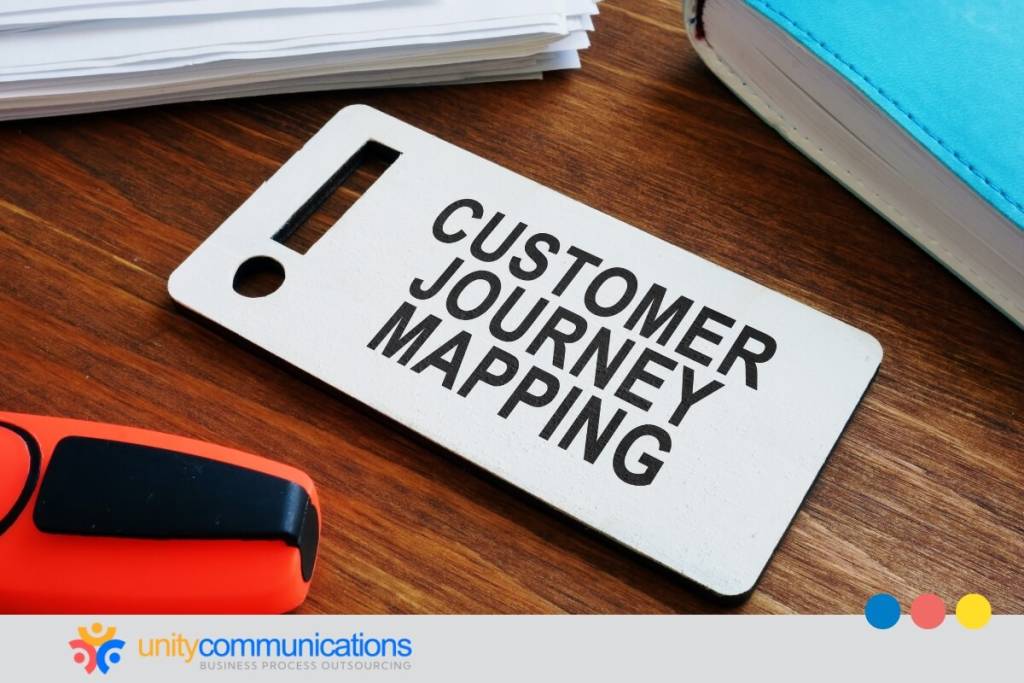Table of Contents
Customer experience (CX) is critical to revenue growth and long-term success. Therefore, business process outsourcing (BPO) firms and client companies must collaborate to optimize the customer journey.
Enter the transformative practice of customer journey mapping, a strategic tool that analyzes each customer touchpoint to significantly improve customer experience (CX).
This article explores how BPO organizations and clients can leverage customer journey mapping to deliver seamless, personalized, and exceptional experiences. Continue reading to learn more.
BPO customer journey mapping and its importance

The customer journey encompasses every touchpoint and interaction a customer has with a client business, from initial awareness of the brand to the purchase decision and beyond.
In BPO operations, customer journey mapping involves visualizing and understanding the various touchpoints and customer interactions with service providers. The process creates a detailed map or diagram outlining each customer journey stage, including points of contact, channels used, emotions experienced, and customer pain points encountered.
Leveraging customer journey mapping is a strategic approach to improving CX. For 73% of buyers, customer experience is a crucial factor in purchasing decisions after product quality and price.
BPO customer journey mapping serves several key purposes:
- Understanding the customer experience. By mapping out the customer journey, BPO providers better understand the customer’s perspective. They gain insight into their needs, preferences, and expectations at each stage of interaction.
- Identifying pain points. Mapping the customer journey identifies pain points or areas of friction in the customer experience. These could include delays in response time, communication breakdowns, or issues with service quality.
- Optimizing processes. Armed with insights from the customer journey map, BPO organizations can identify opportunities to streamline processes, enhance efficiency, and improve the overall customer experience of your business.
- Personalizing interactions. About 76% of customers want personalized support. Customer journey mapping allows BPO firms to tailor interactions and create customized communications to better meet customers’ individual needs and preferences for a more personalized and engaging experience.
- Measuring success. Customer journey mapping provides a framework for measuring the success of customer interactions and tracking improvements over time. Key performance indicators (KPIs) for each stage help monitor progress and identify areas for further optimization.
Steps for creating an effective customer journey map
What is the role of BPO firms in this process? Service providers contribute to developing and utilizing customer journey maps for client businesses.
Effective BPO providers follow several steps to ensure a comprehensive understanding of the CX and increase opportunities to improve customer journey mapping.
BPO organizations follow this guide:
- Define objectives. Clarify the specific goals and objectives of creating the customer journey map. Determine what to achieve, whether improving customer satisfaction, increasing efficiency, or enhancing communication channels.
- Identify customer personas. Develop detailed buyer personas representing different target customer segments. Consider factors such as demographics, preferences, pain points, and communication preferences to create accurate representations of clients.
- Map out the journey stages. Identify the stages that clients go through when interacting with the business. Common stages include awareness, consideration, onboarding, service delivery, issue resolution, and post-service follow-up. Customize these stages to fit the specific context of the BPO operations.
- Gather data and insights. To inform the customer journey map, collect data and insights from various sources, such as customer feedback, surveys, interviews, analytics data, and observations. Use both qualitative and quantitative data to gain a comprehensive understanding of the CX.
- Plot customer touchpoints. Identify and plot buyers’ touchpoints or interactions with the business at each stage. These include phone calls, emails, live chat sessions, in-person meetings, website visits, and social media interactions. Consider both digital and offline touchpoints.
- Capture customer emotions and pain points. Document the emotions and pain points consumers experience at each touchpoint and stage of the journey. Understand how they feel during interactions with the BPO services and identify areas where they might encounter frustration, confusion, or dissatisfaction.
- Analyze cross-channel interactions. Consider how customers move across different channels and platforms during their journey. Analyze how these interactions influence their overall experience and identify opportunities to create seamless and integrated omnichannel customer support.
- Brainstorm solutions and improvements. Collaborate with the team to brainstorm solutions and improvements based on the insights gained from the customer journey map. Identify opportunities to enhance communication, personalize interactions, and address pain points to improve CX.
- Create visual representation. Use diagrams, flowcharts, or journey-mapping software to create a visual representation of the customer journey map. Ensure the map is easy to understand and visually appealing, allowing stakeholders to grasp the CX at a glance.
- Iterate and update regularly. Creating a customer journey map is an iterative process that needs regular reviews and updates to reflect changes in consumer behavior, market trends, and business objectives. Continuously gather feedback, monitor performance metrics, and refine the map to ensure its effectiveness over time.
Challenges in customer journey mapping and how to solve them

BPO providers and clients might face several challenges when undergoing customer journey mapping. Address them with proactive strategies:
Complex journeys
The customer journey involves multiple touchpoints and interactions across various channels, and accurately mapping this is challenging.
Break it down into smaller, more manageable components. Collaborate with subject-matter experts within the organization to gain insights into each stage of the process. Use visualization tools and software to create detailed maps that clearly illustrate the customer journey.
Limited data availability
BPO providers can have limited access to comprehensive data on the customer journey, especially if data is fragmented across different systems or departments.
Invest in data integration solutions to consolidate data from disparate sources. Implement data collection mechanisms such as surveys, feedback forms, and customer satisfaction metrics to gather additional insights.
BPO firms and client companies must collaborate to ensure a more comprehensive understanding of the customer journey. They can establish frequent and structured communication channels, such as weekly meetings and progress updates, to discuss customer feedback, emerging trends, and performance metrics. Another tip is to create a centralized data platform that allows both parties to access, share, and analyze customer data in real time.
Misaligned client objectives
Aligning the customer journey map with the objectives and expectations of client companies can be complicated due to discrepancies in priorities or goals. For example, a client wants to prioritize increasing sales and market share, but the BPO firm focuses on improving customer satisfaction and reducing service costs.
BPO organizations must foster open communication and collaboration with clients to gain a clear understanding of their objectives and expectations. They must also involve clients in the customer journey mapping process to ensure alignment with their goals and regularly review and refine the customer journey map based on client feedback and evolving objectives.
Lost relevance over time
Customer journey maps can quickly become outdated as customer preferences, technology, and market dynamics evolve over time.
Implement a process for regular review and updates to the customer journey map. Monitor changes in customer behavior, market trends, and technological advancements to keep the map relevant. Utilize automation and analytics tools to gather real-time data and insights for ongoing optimization.
Technologies for improved customer journey mapping
Several technologies significantly enhance BPO customer journey mapping and drive improvements in the overall CX. Here are some key technologies to help BPO call center companies:
- Customer relationship management (CRM) system. This tool centralizes customer data and interactions for a comprehensive view of the customer journey. Advanced features such as customer segmentation and predictive analytics provide insights for optimization.
- CX platforms. They offer capabilities such as journey mapping, feedback management, omnichannel engagement, and performance analytics to deliver personalized and seamless experiences.
- Voice of customer (VoC) solutions. This technology captures and analyzes customer feedback to understand sentiment, satisfaction levels, and pain points, guiding improvements in the client experience.
- Process automation and workflow management systems. These tools streamline processes, reduce errors, and accelerate response times with automation, freeing up resources for more value-added activities.
- Artificial intelligence (AI) and machine learning (ML) technologies. Use AI-powered chatbots for real-time assistance and predictive analytics to personalize interactions based on historical data.
- Omnichannel communication platforms. They allow seamless engagement with clients across multiple channels for consistent and personalized communication throughout the customer journey.
The bottom line

BPO customer journey mapping enables service providers to proactively enhance CX, ultimately leading to greater customer satisfaction, loyalty, and business success.
BPO firms are vital in creating, implementing, and optimizing customer journey maps that enhance CX. By leveraging their expertise, data insights, and collaborative approach, they contribute to the success of their clients and drive meaningful improvements in the customer journey.
Let’s connect if you want to learn more about outsourcing best practices!




